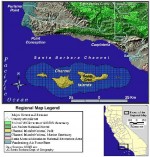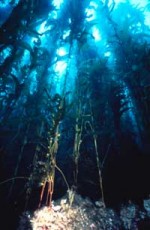Santa Barbara Coastal (SBC LTER)
The Santa Barbara Coastal LTER Project will focus on ecological systems at the land/ocean-margin. This location is typical of many semi-arid regions in that it includes a large number of watersheds with episodic stream flow that vary in size and land use.
The focal coastal ecosystem of our proposed research will be giant kelp (Macrocystis pyrifera) forests, which are extremely important to the ecology and economy of coastal areas along the west coast of North and South America. Kelp forests occur on shallow coastal reefs and are affected in both positive and negative ways by land and the open ocean through the movement of water carrying constituents (e.g. sediments, nutrients, larvae, pollutants) from these different sources. Kelp forests have a unique trophic structure in which producers (macroalgae) and consumers (sessile invertebrates that filter plankton) compete for space. Competition between macroalgae and sessile invertebrates can be mediated by the relative supply of nutrients and particulate organic matter to the reef.
Although several lines of evidence suggest that the effects of terrestrial runoff on kelp forests in the Santa Barbara Channel can be large, the relative contributions of land vs. ocean derived constituents in structuring this and other coastal ecosystems in the region is poorly understood. Interdisciplinary research coordinated among 22 investigators is proposed that will examine questions and hypotheses related to all five core areas of research shared by LTER sites. The key issues that will specifically be addressed are:
- Spatial and temporal scales over which terrestrial runoff and ocean forcing perturbs kelp forest ecosystems
- Patterns and processing of organic matter in the ecosystem
- Patterns of organic and inorganic inputs and their movement from the land to the coastal zone
- The effects of terrestrial runoff on patterns and controls of primary production in kelp forests
- The effects of terrestrial runoff on the long-term population dynamics of key kelp-forest species and on trophic interactions.
Regional studies will combine satellite imagery and field m easurements of discharge from 3 primary and 12 secondary watersheds with modeling of solute and sediment-discharge relationships to determine patterns of runoff entering the Santa Barbara Channel. Detailed sampling of water chemistry and short and long-term experiments will be done in the three primary watersheds to determine smaller scale processes that are critical in controlling overall export to coastal waters. Satellite imagery combined with detailed measurements of ocean currents, waves, suspended sediment, subsurface irradiance, and seawater chemistry collected from moored instruments in the kelp beds offshore of the three primary catchments will be used to determine the timing, spatial extent, and residence time of runoff in the coastal zone and the degree to which they are modified by ocean processes.
The effects of runoff on patterns of primary production will be investigated for both phytoplankton and macroalgae (the two major groups of primary producers found in kelp forests). Phytoplankton production will be estimated from optical data collected from moored instruments and satellites, chlorophyll concentration data collected from moored instruments and ocean cruises and C14 uptake experiments. Kelp production will be estimated from in situ measurements of growth and survival of tagged individuals and aerial photos of surface canopy area. Experiments will be done to evaluate factors that control primary production and the degree to which they are influenced by land and ocean processes. Short and long-term experiments and modeling will be done to determine the extent to which changes in nutrient supply due to runoff alter trophic interactions of the unique food web.

 Enlarge this image
Enlarge this image

